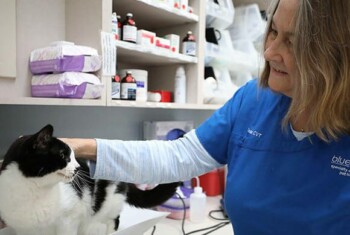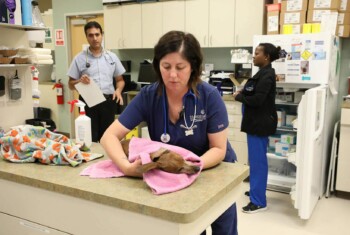Diagnosing canine degenerative myelopathy, a progressively debilitating disease, can be complicated.
The definitive diagnosis of neurologic and neuromuscular disorders usually requires advanced imaging (MRI), CSF analysis, infectious disease testing or even muscle/nerve biopsy. Referring a pet for further diagnostics is the easiest way to get a diagnosis, prognosis and subsequently a prognosis and treatment plan. Not every client is willing to pursue referral, and they often ask our favorite question: “Isn’t there a blood test for this?” Well, sometimes the answer is “Yes!” A subset of neurologic conditions may be diagnosed through genetic testing to identify specific mutations known to be associated with or causative for certain diseases.
Starting with a sample.
If the primary veterinarian is aware of the clinical presentation and neurologic signs associated with these conditions, a definitive or presumptive diagnosis may be made with just a blood sample or cheek swab. Referral may still be necessary since a veterinary specialist can help interpret genetic test results and provide additional guidance about whether advanced diagnostics are still indicated. If a vet does not know if a specific syndrome has a genetic basis, some neurologic diseases with known genetic mutations can be found online at places like the Orthopedic Foundation for Animals (OFA) or by using Dr. Google. Sometimes the genetics are not so “cut and dried,” which leads us to canine degenerative myelopathy as an example.
CDM signs and symptoms.
A syndrome of slowly progressive paraparesis and pelvic limb ataxia, canine degenerative myelopathy (CDM) or radiculomyelopathy, was first described in German shepherds in the early 1970s. The initial change in gait is typical of a thoracolumbar (T3-L3) myelopathy and, most importantly, this gait change is not specific to CDM. Dogs with degenerative myelopathy will inevitably progress to being unable to walk and eventually deteriorate to flaccid paraplegia with loss of pelvic limb reflexes. This change occurs over the course of 12-18 months with most dogs becoming unable to walk after about 10 months.
In later stages of the disease, thoracic limb weakness, tetraplegia and dysphagia develop but most dogs are euthanized prior to this. The onset of signs is >8 years of age in most cases, with age at onset being later (11 years of age) in the Pembroke Welsh corgi (PWC). In the early stages of the disease, axonal and myelin degeneration with astrogliosis is found within the thoracic spinal cord. Lower motor neuron pathology and neuronal degeneration within the cervical spinal cord and brainstem develop later in the disease as is expected by the clinical progression.
The superoxide dismutase gene (SOD1).
CDM is most often seen in German shepherds, PWC and boxer dogs; however, CDM has been histologically confirmed in over 20 breeds. Through the University of Missouri, a genome-wide association map of a group of PWC dogs with CDM identified a single nucleotide mutation in the superoxide dismutase gene (SOD1). Approximately 20% of familial amyotrophic lateral sclerosis (ALS or Lou Gehrig’s disease) cases and 1-5% of sporadic ALS are associated with mutations in SOD1, making this a likely candidate gene.
Further research found that dogs with degenerative myelopathy develop detergent-insoluble aggregates of SOD1 within the cytoplasm of neurons in the spinal cord. Two copies of this mutation, referred to as a SOD1A mutation by some reference labs, is strongly correlated with the development of CDM. Another SOD1 missense mutation (SOD1B mutation) was subsequently identified in only Bernese mountain dogs with CDM.
Disease-modifying genes.
Clinical disease has also been seen in dogs with both mutations (a compound heterozygote). In a study looking at 168 dogs with histologically confirmed CDM, only eight dogs were found to be heterozygotes for the SOD1A mutation with no other known mutation. So, if a dog has signs of a T3-L3 myelopathy but has two normal copies of the SOD1 gene or is a carrier for the SOD1A/SOD1B mutation, then CDM is unlikely.
What about dogs that are homozygous positive for a SOD1 mutation but have no clinical signs? In a small survey of dogs that were homozygous for the SOD1A mutation but were clinically normal when less than 8 years of age found only 60% of the dogs had developed clinical signs when reassessed at >10 years of age. Therefore, this mutation alone does not ensure the development of the disease, and there are likely disease-modifying genes that alter the clinical progression.
Genetic testing for CDM is available through the University of Missouri but also through private companies like OFA. It must be emphasized that early stages of CDM are clinically identical to any other thoracolumbar myelopathy as is seen with chronic intervertebral disc disease, stenosis or a slow-growing tumor. Magnetic resonance imaging (MRI) is still considered the gold standard for the diagnosis at this stage.


